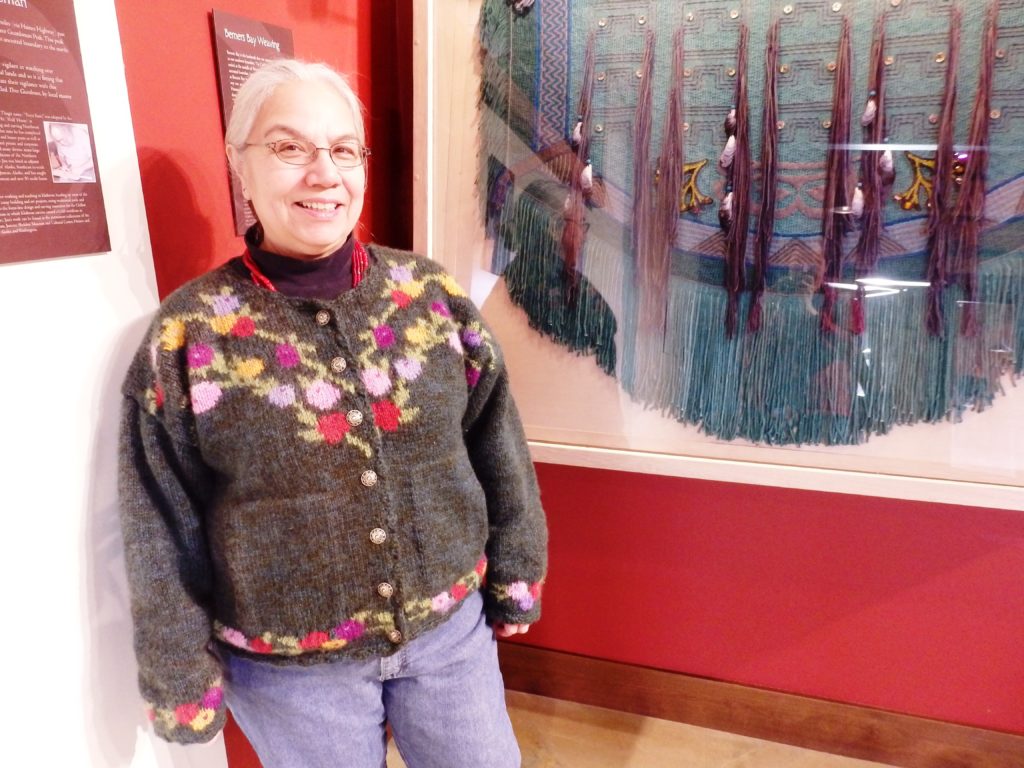
It was a historic year for the Chilkat Indian village of Klukwan. After more than a decade of work, the Jilkaat Kwaan Cultural Heritage Center opened its doors in May.
The center tells the still-evolving story of the Chilkat people and also houses some of the world’s most admired works of Northwest Coast Art, the Whale House Collection.
“The first thing that you see when you walk into our exhibit gallery is the Chilkat cultural landscape map,” said Lani Hotch, the executive director of the heritage center. “And we see the interpretive panel here, Jilkaat Kwaan Aani, the land of the Chilkat people.”
“And there’s a quote there, Aan Yatku Saani. It’s a formal way to address a group of people,” she said. It means “honorable people of the land.”
“I thought that was so appropriate because whether you live in a little house along the Chilkat River or a skyscraper in Manhattan, we’re all dependent on the land.”
Hotch is one of the Klukwan residents who led the enormous effort to build this cultural center. Klukwan is a village of about 100 people, and the cost of the center is close to $8 million.
The idea for a cultural center has been around for almost a century. But the effort that finally led to success began with a strategic planning session about 15 years ago.
“We went through this visioning process, what we wanted Klukwan to look like in five years, 10 years, 20 years. This is a huge part of that vision,” she said. “So it’s really cool to see it come to pass.”
Hotch said they talked about Klukwan’s strongest assets: a rich cultural heritage and a beautiful landscape.
“The idea behind this building is not so much museum, but a culture center, where people can still carry their culture forward.”
You can see the emphasis on the living culture throughout the center. One example is a weaving exhibit that honors the past and present.
“Klukwan is well-known for our legacy of weaving here,” Hotch said. “Chilkat weaving didn’t originate with the Chilkat people, it originated with the Tsimshian people, but our people became so talented and prolific that the art form became known as Chilkat weaving.”

Hotch herself is a master weaver skilled at creating Chilkat blankets. She made a contemporary weaving representing Berners Bay for the center’s cultural landscape map.
Just outside of Juneau, Berners Bay is the southern boundary of the Chilkat people’s ancestral homeland.
Hotch’s weaving is a bright aqua color with patterns and shapes that make it totally distinct from Chilkat weaving. She says some people frowned on this.
“They wanted to see me weaving Chilkat because that’s our legacy here, but I’m of the opinion that each generation has a right to impact their culture,” she said. “A right, if not a duty.”
The contemporary weaving isn’t the only piece of the exhibit that stirred some controversy.
The heart of the cultural center is a collection of masterful artworks that are between 200 and 300 years old.
The Whale House rain screen and house posts are arranged to create a functioning clan house within the center. (Note: KHNS was not permitted to take photos of the Whale House artifacts.)
“I don’t think anyone could ever duplicate what we’re looking at,” said Jones Hotch Jr., the Gaanaxteidi clan leader and caretaker of the Whale House. He also is Lani Hotch’s husband. “What the four house posts and rain screen, what I say is, that’s our birth certificate. It tells us where we’re from.”
During the planning of the cultural center, the Gaanaxteidi clan agreed to house the objects here, even though putting them in a public place is a break from tradition.
One reason to keep them here is for protection. Over the last century or so, there have been multiple attempts to remove the Whale House artifacts and display them outside of Klukwan.
“So many of our at.oow, our objects are in different museums. And it’s like they’re not home,” Jones Hotch said. “This is, what we’re standing on, this is their homeland.”
The day the Whale House objects were returned to Klukwan, it was raining, he said.
“I said it’s the elders are crying, they’re happy they’re getting back to Klukwan.”
Lani Hotch said the most gratifying thing about the center opening is seeing young people getting involved.
Her hope is that the cultural center will bring back people who haven’t been able to find employment in Klukwan before.
“This is their future, and that’s why we did it.”
She can already see that happening.
The center employed about 25 people during the summer.
In a village of about 100, it’s a big impact. Hotch says that makes the enormous effort it took to bring the center to life worth it.
The Jilkaat Kwaan center will host workshops and classes periodically throughout the winter.
It will open again for tours in the spring.
